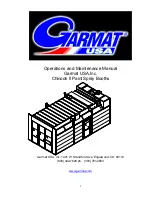
17
160S
lue
series
b
160S
160S
160S
controls
controls
160S
notes
notes
160S
160S
160S
Operations
160S
160S
160S
160S
160S
160S
160S
160S
160S
160S
160S
160S
160S
160S
160S
Operations
Inspection
Inspection
Operating
Operating
Operating
Operating
Connection
Connection
Installation
Installation
Technical
Technical
Introduction
Introduction
to your system
to your system
considerations
considerations
contents
contents
concept
concept
diagram
diagram
applications
applications
support and factory service
support and factory service
160S
Specifications
Specifications
160S
160S
160S
160S
160S
160S
Manual
Manual
Design
Design
Block
Block
Controls
Controls
Advanced
Advanced
Warranty
Warranty
lue
series
b
Using The Stereo Couple Switch
Two channels of program material do not necessarily constitute a stereo program. A stereo program is one where
the two channels are recorded and/or mixed to create the illusion of a single unified panorama of sound. The
stability of the psychoacoustic image of each sound source within the stereo spectrum depends upon its ability
to maintain a specific phase and amplitude relationship from the left to the right channel.
If two independent compressors are used to process the stereo program, a loud sound occurring in one channel
will cause a gain reduction only in that channel. This gain reduction would cause the perceived image of any
sound spread between the two channels to move toward the side which had not been compressed, because the
spread signal would be momentarily softer in the compressed channel. This can be avoided by linking the two
compressors in such a way that both channels receive the same amount of compression. On the 160SL, this is
accomplished by means of the
Stereo Couple
switch. When activated, the 160SL permits the RMS detectors of
both channels to “talk” to one another. The LINKED channel (right, channel 2) then sends its signal to the HOST
channel (left, channel 1), where the RMS power of the HOST and LINKED signals are combined to generate a
control voltage. This control voltage is then used to compress both the HOST and LINKED channels equally. This
dbx process is called True RMS Power Summing
™
When compressing a stereo program with a 160SL, only the HOST channel controls need to be adjusted. The
Threshold
LEDs,
Auto
LED, and
PeakStop (Plus)
LED will not light on the “linked” channel when the 160SL
is stereo linked. The
Bypass
switch and LED,
Sidechain
switch and LED, and the
Meter Mode
switches and
LEDs remain channel-independent and function normally in
linked
mode.
Using The Auto Switch
The
Auto
switch sets the 160SL for automatic or manual operation. When the
Auto
switch is IN (
a
utO
mode),
the LED indicator lights and the 160SL automatically adjusts its attack rate and release time to suit the program
envelope. (This
a
utO
mode sets the 160SL for the same attack and release characteristics as dbx Models 160, 161,
162, 163, and 164 compressor/limiters, the LED indicator above it turns OFF, and the front panel
Attack
and
Release
rate controls determine the maximum rate of gain change and the behavior of the level detector circuitry.
Setting The Attack And Release Controls
The 160SL offers a choice of automatic or user-adjustable attack and release characteristics. In
a
utO
mode, the
160SL utilizes the patented dbx RMS level detector with its program-dependent attack/release characteristics to
obtain natural-sounding compression or limiting. For special effects and certain signal situations, however, it is
often desirable to set fixed attack and release characteristics.
m
anual
mode affords this capability. The
a
utO
mode
is recommended for vocals as well as instruments. Because the
a
utO
mode has a variable attack rate, the 160SL
may compress or limit some program material smoother than in the
manual
mode which has a fixed attack char-
acteristic. This is especially true on vocals.
There is no
right
way to set the
Attack
and
Release
controls. Generally, you want a slow enough attack to avoid
pumping
or
breathing
sounds caused when background sounds are audibly modulated by the dominant signal energy,
yet the release must be fast enough to avoid suppression of the desired signal after a sudden transient or a loud
note has decayed. Depending on the desired effect, you might want a very slow attack so that percussive or
transient sounds are not restricted, but average volume levels are held within the desired range.
A very fast attack setting (control maximum counterclockwise) will cause the 160SL to act like a peak limiter even
though RMS detection circuitry is used. Slower attack settings cause the 160SL to act like an RMS or averaging
detecting compressor/limiter.
160SL
lue
series
b
160SL
160SL
160SL
controls
controls
160SL
notes
notes
160SL
160SL
160SL
Operations
160SL
160SL
160SL
160SL
160SL
160SL
160SL
160SL
160SL
160SL
160SL
160SL
160SL
160SL
160SL
Operations
Inspection
Inspection
Operating
Operating
Operating
Operating
Connection
Connection
Installation
Installation
Technical
Technical
Introduction
Introduction
to your system
to your system
considerations
considerations
contents
contents
concept
concept
diagram
diagram
applications
applications
support and factory service
support and factory service
160SL
Specifications
Specifications
160SL
160SL
160SL
160SL
160SL
160SL
Manual
Manual
Design
Design
Block
Block
Controls
Controls
Advanced
Advanced
Warranty
Warranty
lue
series
b
Содержание dbx 160SL
Страница 1: ...Stereo Compressor Limiter 160SL Owner s Manual ...
Страница 10: ......












































